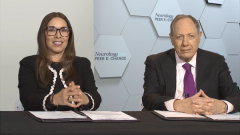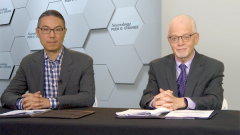
Effects of Polymorphism in the Use of Anti-CD19 and Anti-CD20 B-cell Therapy in NMOSD
Robert Shin, MD, FAAN, discusses the potential advantages of using inebilizumab over rituximab in the treatment of NMOSD.
Episodes in this series

Brian Weinshenker, MD: I’m going to stick with you, Bob. Can I ask you whether you think there’s any theoretical or demonstrated advantage of using inebilizumab over rituximab? Some would argue that they’re both B-cell depleters, and that if you had a patient who didn’t do well on rituximab, you should choose a different mechanism of action. Is that something that you would agree with? Or do you think that there may be some option that the patient may respond better than inebilizumab?
Robert Shin, MD, FAAN: Right. This is a challenging question in some sense. I have to be honest, there was a time when I thought, well B-cell therapy is B-cell therapy. What would the difference be really? Maybe we haven’t made it explicit that before the advent of FDA-approved therapies, of course, we were trying to treat NMO [neuromyelitis optica] spectrum disorder off-label by definition. At least in my practice, I did turn to rituximab frequently as an anti-CD20 agent. That’s what I was using to try to combat NMO spectrum disorder. I think with time, and the ability to understand inebilizumab a little bit better, I’ve changed my mind quite a bit, to be honest with you.
One was the distinction between CD20 and CD19, which again, sometimes we say B-cell therapies, but not all B cells express CD19 or CD20. Stem cells in the bone marrow generally don’t express CD19 or CD20. Then we talked about plasmablasts and plasma cells. The mature B cells that manufacture antibodies for instance don’t express CD20. When we use anti-CD20 agents as a mask for example, we’re avoiding the cells that we think would be involved in antibody production. When we turn to an agent like inebilizumab, which targets a broader spectrum of B cells, such as plasmablasts and some plasma cells that produce antibodies that express CD19, in my opinion, we might be affecting a broader cell population, which would be valuable in a disorder like NMO spectrum disorder, which has turned out to be antibody-mediated. I would say other subtle distinctions may have to do with the antibody molecule itself, which we might discuss later as it might also have differences in the efficacy of these particular products.
Brian Weinshenker, MD: While we’re on that subject, there is a polymorphism on the Fc [fragment crystallizable] gamma receptor 3a that’s involved in binding to the Fc portion of IgG [immunoglobulin]. There are 2 different alleles: valine and phenylalanine. Valine is a high-infinity allele. There is some evidence from studies done in South Korea that suggest that rituximab may be less effective in those people who do not have a valine allele and have low-infinity phenylalanine allele exclusively, especially the homozygous. Recent studies that have been done on inebilizumab seem to suggest that’s not the case for inebilizumab. Do you think that’s important?
Robert Shin, MD, FAAN: It’s so interesting you’re faced with that information. I learned that this is something that had been known in the oncology literature. I have to admit, until relatively recently, I was not really aware of this. It’s fascinating when I think about it. We think of these antibodies as targeting B cells or cells that express CD19, but we forget that the conserved portion of the antibody that’s the target for the cell [s going to get rid of that B cell. This observation that a very significant proportion of humans, at least crans like myself, I think in humans, it’s possible that a genetic polymorphism would mean that that cell may not bind to the antibody as effectively, and possibly result in less effective clearance. This may explain why not everyone benefits from treatment with rituximab.
It isn’t a polymorphism that we’ve been testing for in advance. The idea that a different antibody, inebilizumab in this case, doesn’t seem to be susceptible to the same effect might imply to me that we can have in some sense more consistent and reliable binding to the antibody and thus more effective clearance. That’s another factor that makes me think that maybe CD20 and CD19 agents are not necessarily identical.
Transcript edited for clarity
Newsletter
Keep your finger on the pulse of neurology—subscribe to NeurologyLive for expert interviews, new data, and breakthrough treatment updates.























